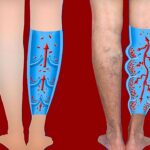PAD or peripheral artery disease is a disorder of the arteries that supply blood to the peripheries (arms and legs). The arteries become narrow which reduces the blood flow towards the peripheries. It occurs more commonly in legs than in arms. The frequency is equal for both males and females. The relationship between high cholesterol and PAD is something people are concerned about. A patient may experience the symptoms and complications of PAD without high cholesterol.
Symptoms may include peripheral cramps, fatigued arms or legs, hair loss, pain within the extremities that can radiate through the proximal body parts, and pain while walking.
Main Cause of PAD
The main cause of peripheral artery disease is the deposition of plaque or fats in the vessels that obstruct the flow of blood. Risk factors include old age (over 60 years), obesity, smoking, alcoholism, atherosclerosis, high cholesterol levels, and Diabetes. While developing Peripheral Artery Disease (PAD) is a potential risk factor for Cerebrovascular Disease or Coronary Artery Disease.
High Cholesterol and PAD
As high cholesterol level is a potential risk factor for peripheral artery disease, it is not always necessary to have high cholesterol to develop PAD. The other risk factors excluding high cholesterol can play a vital role in developing PAD.
Peripheral Artery Disease is caused by the deposition of fatty plaque within the vessels. The reason is that despite being a major risk factor it is not important to have high levels of cholesterol to deposit fat over the walls of the blood vessels – As the plaque does not only contain cholesterol or LDL. Other fatty contents such as fibrin, deposits of calcium, or cell waste remains can also form fatty plaque that deposits within the vessels causing Peripheral Artery Disease.
Factors That Cause PAD
Another factor that can cause Peripheral Artery Disease without having a high cholesterol level is smoking. Already being a risk factor it can further interfere with a person’s normal cholesterol level and make it a potential threat for PAD. Smoking reduces the normal level of good cholesterol that is HDL (High-density lipids) while minimally making the bad cholesterol LDL (Low-Density Lipids) sticky even if the person has normal levels of LDL. Due to the density of LDL, it deposits over the vessels and can lead to Peripheral artery Disease.
So to answer the question we can say that a person can still develop PAD without having a high level of cholesterol. It is necessary to evaluate your health status monthly to reduce the risk of any potential vascular diseases. Book an appointment with our certified vascular surgeons and interventional radiologists to ensure that you get timely treatment to avoid any serious complications.




